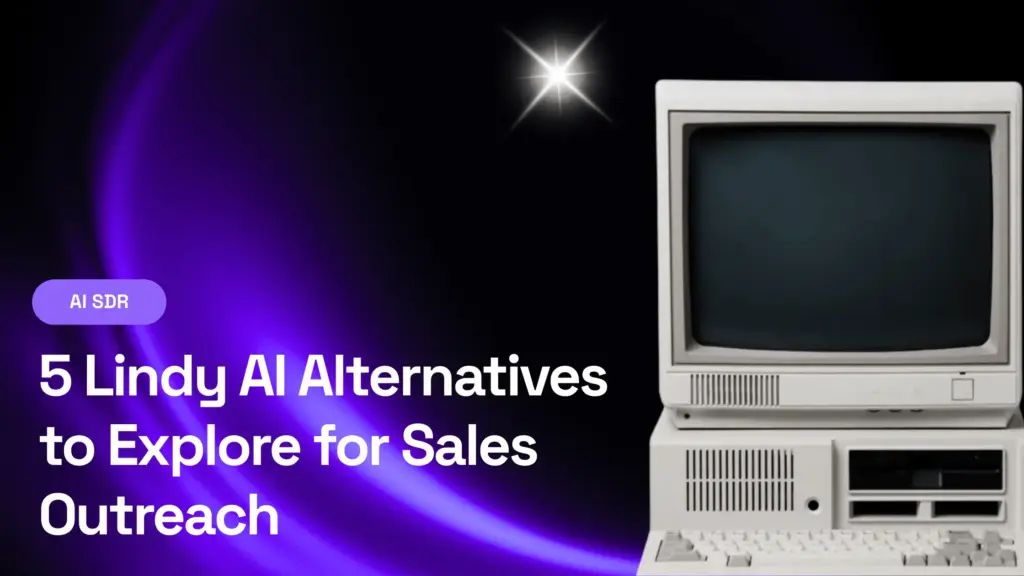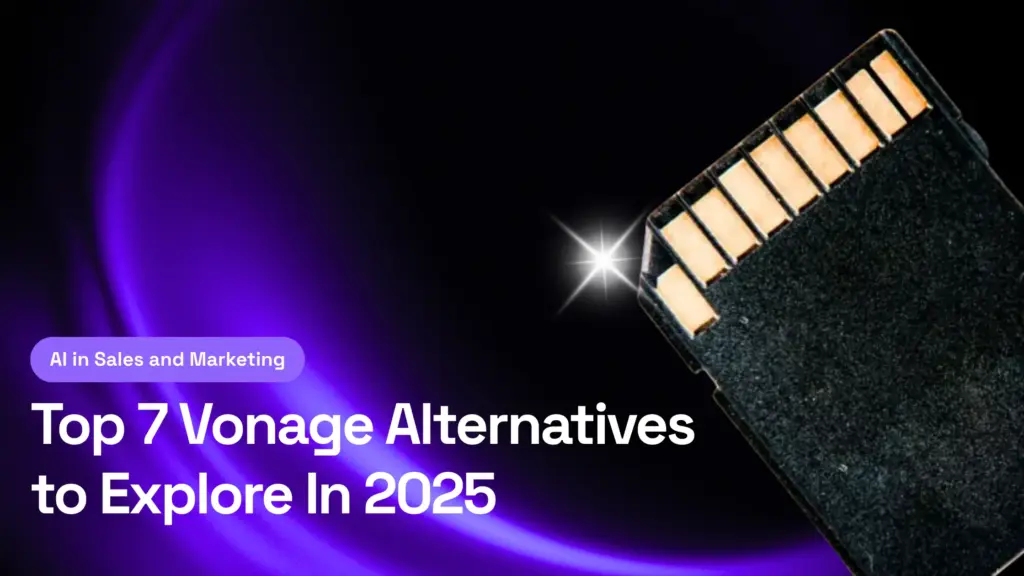Cold email campaigns have been and always will be a vital part of your marketing outreach.
Part of it has a non-intrusive approach allowing prospects to respond to the email at their own time.
But the future of cold emailing has been undergoing some new developments, and is changing faster than ever, especially with Artificial Intelligence (AI).
From the generic spray-and-pray tactics, personalized emails are now becoming the new and most critical strategy that has become a revelation for the entire sales teams and the development of their process.
However, not all AI-generated emails are created equal. To write cold emails that get responses you need more than just a cold email template and automation, you need thoughtful input and avoid the risk of sounding too robotic, irrelevant, or worse —spammy.
For this blog, we will guide you on how to craft cold sales emails with the help of AI and how to actually get replies, and perhaps the best cold email tool that will showcase the real power of AI in your cold emailing process — AnyBiz. Whether you’re using GPT-based tools or a full-stack solution like AnyBiz, this guide will help you fine-tune your campaigns and boost your reply rates.
Understanding Cold Emails: What Makes Them Effective?
Cold outreach is part of email marketing, which involves sending a message to prospect who may have no prior contact or engagement with you.
Compared to newsletter, warm outreach, or customer success emails, every cold email outreach endeavors to create new relationships with potential prospects. They are a cornerstone of outbound sales and are often the first impression a prospect has of your company.
Effective and compelling cold emails share several traits:
- Clear Subject Line: It grabs attention to improve your open and response rates without sounding clickbaity.
- Relevant Content: Email body; the message resonates with the recipient’s challenges or goals.
- Personalization: It speaks to the reader as a human, not a segment.
- Strong Call to Action (CTA): It gives a simple next step without being pushy.
- Brevity: It respects the reader’s time.
When done right, cold emails can open doors, start conversations, and drive revenue. When done poorly, they end up in the spam folder.
Leveraging AI for Cold Email Personalization
Besides sending AI-generated cold emails, AI in cold emailing tools also have the capacity to analyze CRM data, web behavior, and past interactions to identify patterns and craft messages that speak to individual needs.
Platforms like AnyBiz.io take this a step further by allowing deep customization through scripts and instructions.
How Can AnyBiz Help Personalize Cold Emails at Scale?
AnyBiz lets you tailor communication and create cold emails that actually get a conversion using structured scripts and flexible instruction modules:
Personalization Capabilities: Instructions and Scripts for the AI Agent
AnyBiz makes cold emails personalized by enabling users to instruct the AI agent to whatever they deem necessary when sending cold emails. It functions more than some generic AI writer or cold email generator, it ensures that you send personalized emails for you to achieve better results from your cold email.
- Communication Tone: You can tell the agent to align with your brand’s voice—be it formal, friendly, or consultative.
- Handling Objections: Train the AI to recognize common objections and respond accordingly, increasing trust and credibility.
- Focusing on Client Problems: Guide the AI to ask discovery questions that dig into a prospect’s specific pain points.
Setting Up Responses to Common Questions
You can program the agent to handle FAQs about pricing, product specs, or onboarding processes—ensuring a smooth buyer journey.
What Data Points Should You Analyze for Effective Personalization?
- Job title and industry
- Company size and tech stack
- Recent funding or news mentions
- CRM activity history
- Website behavior and intent signals
When these data points are used thoughtfully, AI can build outreach messages that feel surprisingly human.
Crafting the Perfect Subject Line
Cold emails that grab attention most often rely on how compelling and attention-worthy their subject line is.
Subject lines are your foot in the door. If they fail, no one reads the rest.
Although AI can write generic email subject lines, you can make your cold email get results by instituting A/B testing variation.
AI tools can help by A/B testing variations and analyzing which ones earn the highest open rates. By processing thousands of subject lines across industries, AI can identify which formats, word choices, and tones perform best.
What Are Some Examples of High-Performing Subject Lines?
Some of the best examples of subject lines that you can use as part of your email campaign are:
- “Quick question about [Company Name]”
- “[First Name], struggling with [Pain Point]?”
- “Idea for improving your [Goal]”
- “Thought this might help you with [Challenge]”
- “[Your Company] <> [Their Company]”
These work because they are relevant, curious, and direct—without being gimmicky.
Writing Engaging Email Content for Effective Outreach
One of the questions that you need to ask yourself when crafting cold emails is the type of tone and language you should use.
Do you want your cold emails that sound professional? Friendly? Conversational?
Part of exercising personalized emails at scale is setting your tone. Your tone should reflect your brand and your audience. AI tools can adapt tone based on parameters you set: friendly for startups, professional for enterprise, casual for creatives.
Avoid jargon. Use short, active sentences. Sounds like a human, not a press release.
How Can Storytelling Enhance Your Email Content?
There is a reason why most of us are drawn in by good stories, genuine cold emails — and the kost successful ones are those that actually tell stories for its intended recipients.
It can make them care, and upgrade your cold email game by a long shot.
But how can you incorporate storytelling to initiate a successful cold email campaign?
Make them care.
Use micro-stories that will urge them to care, cold emails tailored to your audience have a higher chance of them engaging. You can incorporate some micro-stories, or make your entire cold email about that.
Here are some examples:
- “We helped a company like yours increase their demo rates by 35% in 30 days.”
- “After launching with [Client Name], they saw a 2x ROI within the first month.”
These anecdotes make your email feel relatable and outcomes feel tangible.
What Role Does AI Play in Generating Relevant Email Content?
The power of AI in cold calling and email content can be instrumental or conceptual.
Despite making your entire cold emailing journey more automated, AI in email content help you with phrases that trigger engagement based on industry benchmarks, suggest relevant success stories — or case studies, and propose dynamic snippets tailored to job roles or industries.
AI tools such as AnyBiz can help you write a cold email under its messaging section, to which you can configure your parameters and achieve deeper personalization effective cold emails.
Under the Configurations section on the AnyBiz dashboard, you can select messaging to customize the message settings.

Then you can select Messaging to customize message settings.
- Message Type: Choose the type of message (e.g., welcome email, follow-up, reminder, etc.).
- Offering: Select the specific offering to be included in the message.
- Personas: Choose the persona for which the message will be created.
- Language: Set the language of the message.
- Tone of Voice: Select the communication style (friendly, professional, neutral).
- Call to Action: Customize the call to action to motivate the recipient.
- Signature: Set up the signature for each message.
- Case studies/big customers/special info: Add specific case studies, major clients, or special information to increase relevance.
- Additional instructions: Provide additional instructions for more detailed personalization
Incorporating a Strong Call to Action
Your call-to-action (CTA) will define the outcome of the rest of your email. CTAs offers a suggestion to your prospect on the next possible action they can do after they read your email. Some of the most effective CTA in a cold email are
- Clear (“Book a 15-minute call”)
- Low-friction (“Reply if interested”)
- Relevant (“See a custom demo for [Company Name]”)
How Can AI Tools Help Optimize Your Call to Action for Conversions?
AI tools such as AnyBiz can help define CTAs and tell your recipients the actions your recipient can take after reading the email. This can include.
- Schedule a Demo Call
- Watch a Demo
- Offer a Free Trial
- Provide a Free Consultation
- Offer to Visit a Website
What Are Common Mistakes to Avoid in Your Call to Action?
CTA is a crucial element of your email, even a well-written email can fall flat especially for emails that feel generic, boring or lacking in energy. Here are the biggest pitfalls:
- Too many CTAs: Giving someone multiple options like “Book a call, download our brochure, or connect on LinkedIn” creates choice paralysis. Stick to one clear action.
- Being vague: CTAs like “Let’s connect” or “Touch base soon?” don’t tell the reader why or how. Be specific.
- Over-asking: If your first email asks for a 60-minute strategy session, that’s a big ask from a cold contact. Start with micro-commitments like a quick reply or a 10–15-minute chat.
- Ignoring context: A CTA should match the value you’ve provided in the email. If you haven’t demonstrated relevance yet, asking for a meeting can feel premature.
Testing and Analyzing Your Cold Emails
Why Is A/B Testing Important for Cold Emails?
A/B testing helps you understand what works and what doesn’t. AnyBiz simulates this through multiple AI “Personas” that use slight variations in tone, phrasing, or structure. These personas run simultaneously to reveal which combinations drive better results.
You can find this under the Performance Tab > Insights Tab in the AnyBiz Dashboard. Metrics include:
- Opportunity creation
- Target audience response trends
- Open, click, and reply rates
These are just some of the most important metrics you need to keep track of.
How Can AI Analytics Enhance Your Email Performance Insights?
AI-driven cold email strategy should run through a great deal of sales intelligence and analytics, choosing a tool for this will be necessary. They don’t just crunch numbers—they unlock smarter decisions that lead to better results. With the right tools in place, AI acts like a performance coach that’s always on, analyzing your outreach from every angle. Here’s what it can do:
Detect Patterns Across Campaigns
AI scans thousands of data points—subject lines, open rates, CTA phrasing, send times—and identifies what’s consistently working (or failing). It can surface patterns like:
- Emails sent on Tuesdays with personalized intros perform 15% better.
- Messages under 120 words have a higher reply rate in SaaS industries.
Flag Underperforming Templates
Rather than guessing which version of your email is the problem, AI shows you. It pinpoints templates that fall short in opens, clicks, or replies and helps you replace or refine them before wasting more leads.
Suggest Improvements Based on Benchmarks
Using industry and historical data, AI tools offer actionable suggestions. For instance:
- “Your CTA is buried too deep—top-performing emails in your niche place it by sentence 3.”
- “Subject lines with a number or question perform 22% better in B2B tech.”
Predict Which Contacts Are More Likely to Engage
AI can score leads based on signals like job title, engagement history, or behavior across channels. This lets you:
- Prioritize high-potential prospects.
Personalize emails for specific segments. - Avoid wasting time on cold leads that rarely convert.
AI analytics bring visibility to your blind spots. It’s no longer about sending more—it’s about sending smarter.
Best Practices for Follow-Up Cold Email Campaigns
When and How Often Should You Follow Up on Your Cold Emails?
A good rule of thumb: 3-5 follow-ups spaced over 10-14 days.
AI can schedule these follow-ups based on:
- Recipient behavior (e.g., opened but didn’t reply)
- Day/time performance trends
- Prospect’s typical engagement window
What Strategies Can You Use to Craft Effective Follow-Up Emails?
- Vary your value proposition in each email
- Use different subject lines and tones
- Reference the previous email and build on it
AI helps by auto-generating follow-ups that complement the original message instead of repeating it.
The Future of Cold Email is AI
AI is transforming sales and marketing for good. Choosing a platform like AnyBiz to leverage cold email would not just help you remain competitive you can achieve great success.
You have to use AI to continue and adapt your strategies, update your scripts from the most you send emails to the moment you follow it up.
Remember that AI cold emails are as effective as you allow it to be, so do not limit it to automated cold emails and sending, cold emails aren’t an advantage, it is a necessity.
By applying the right AI tools, feeding them clean data, and guiding them with thoughtful instructions, you can write cold emails that scale—without losing the human touch. Start small, test often, and optimize constantly. Your inbox (and calendar) will thank you.
Try AnyBiz or book a demonstration meeting today! Or try it out for a very low price trial starts at 0.99 USD.



